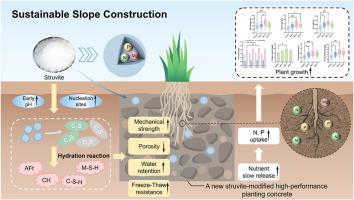一种新型鸟粪石改性植物混凝土用于可持续护坡和环境修复
IF 7.7
2区 环境科学与生态学
Q1 ENVIRONMENTAL SCIENCES
引用次数: 0
摘要
传统的密实混凝土护坡提高了物理稳定性,但阻碍了水土交换,降低了生态功能。种植混凝土提供了一种可持续的替代方案,但在营养调节和长期植物支持方面仍然存在挑战。虽然富含营养的固体废物矿物具有巨大的潜力,但其在混凝土种植中的多功能作用却很少被探索。为此,研制了一种具有平衡机械性能和植被性能的新型鸟粪石改性植物混凝土(SPC),用于可持续的边坡保护和环境恢复。其中,SPC-6的物理性能最佳,抗压强度为13.1 MPa,劈裂抗拉强度为2.1 MPa,孔隙率为31.4%,同时保证了结构强度和渗透率(最低系数为4.5 mm/s)。鸟粪石的掺入改善了吸水率、碱度调节和抗冻融性能,SPC-6经过50次循环后质量和强度损失最小。水化热和热重分析表明,SPC-6的水化活性增强,累积热最高(77 h后为97.3 J/g),残余质量最低(72.3%)。与之相对应的是,SPC-6的植被表现较好,其干重(0.087 g)、蛋白质含量(5.3 mg/g)和叶绿素含量(2.3 mg/g)最高,30 d养分积累量(6.0%全氮和9.4 mg/g全磷)最高。养分淋溶试验显示,氮磷持续释放,28 d时SPC-6 NO3−-N和PO43—P分别达到22.2 mg和1.1 mg,有利于植物生长的改善。本研究为多功能生态混凝土设计提供了新的思路,促进了环境应用中的物理稳定和生态恢复。本文章由计算机程序翻译,如有差异,请以英文原文为准。

A novel struvite-modified planting concrete for sustainable slope protection and environmental restoration
Conventional dense concrete for slope protection enhances physical stability but impedes water-soil exchange and degrades ecological functions. Planting concrete offers a sustainable alternative, yet challenges remain in nutrient regulation and long-term plant support. Although nutrient-rich solid waste minerals hold great potential, their multifunctional roles in planting concrete have been rarely explored. Herein, a novel struvite-modified planting concrete (SPC) with balanced mechanical and vegetation performance was developed for sustainable slope protection and environmental restoration. Among the samples, SPC-6 exhibited optimal physical properties with a compressive strength of 13.1 MPa, splitting tensile strength of 2.1 MPa and porosity of 31.4 %, ensuring both structural strength and permeability (lowest coefficient: 4.5 mm/s). Struvite incorporation improved water absorption, alkalinity regulation and freeze–thaw resistance, with SPC-6 showing the lowest mass and strength loss after 50 cycles. Hydration heat and thermogravimetric analysis indicated enhanced hydration activity, with SPC-6 exhibiting the highest cumulative heat (97.3 J/g after 77 h) and the lowest residual mass (72.3 %). Correspondingly, SPC-6 was superior in vegetation performance with the highest recorded dry weight (0.087 g), protein content (5.3 mg/g), and chlorophyll content (2.3 mg/g), along with the highest 30-d nutrient accumulation (6.0 % total nitrogen and 9.4 mg/g total phosphorus) in the ryegrass plant. Nutrient leaching tests showed sustained N and P release, with SPC-6 reaching 22.2 mg NO3−-N and 1.1 mg PO43--P at 28 days, supporting improved plant growth. This study offers insights into multifunctional eco-concrete design, promoting physical stabilization and ecological restoration in environmental applications.
求助全文
通过发布文献求助,成功后即可免费获取论文全文。
去求助
来源期刊

Environmental Research
环境科学-公共卫生、环境卫生与职业卫生
CiteScore
12.60
自引率
8.40%
发文量
2480
审稿时长
4.7 months
期刊介绍:
The Environmental Research journal presents a broad range of interdisciplinary research, focused on addressing worldwide environmental concerns and featuring innovative findings. Our publication strives to explore relevant anthropogenic issues across various environmental sectors, showcasing practical applications in real-life settings.
 求助内容:
求助内容: 应助结果提醒方式:
应助结果提醒方式:


